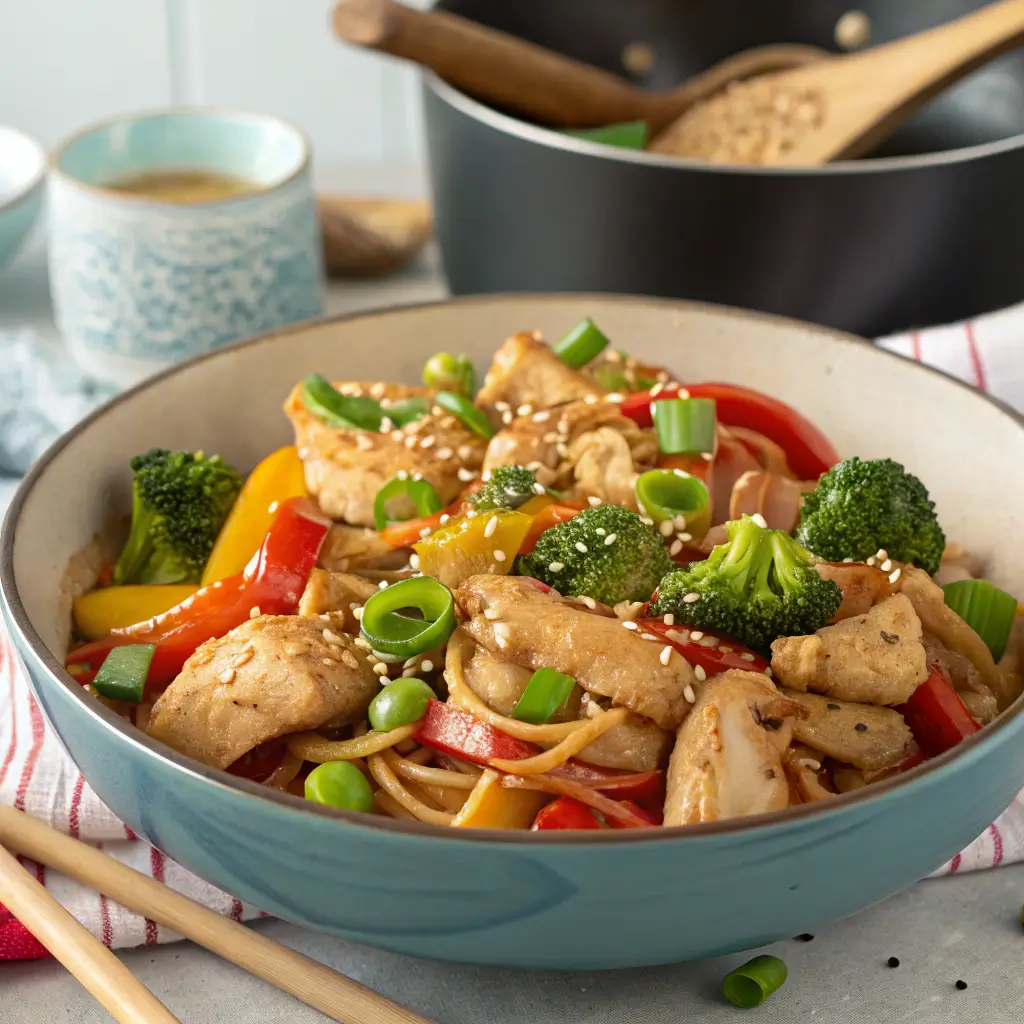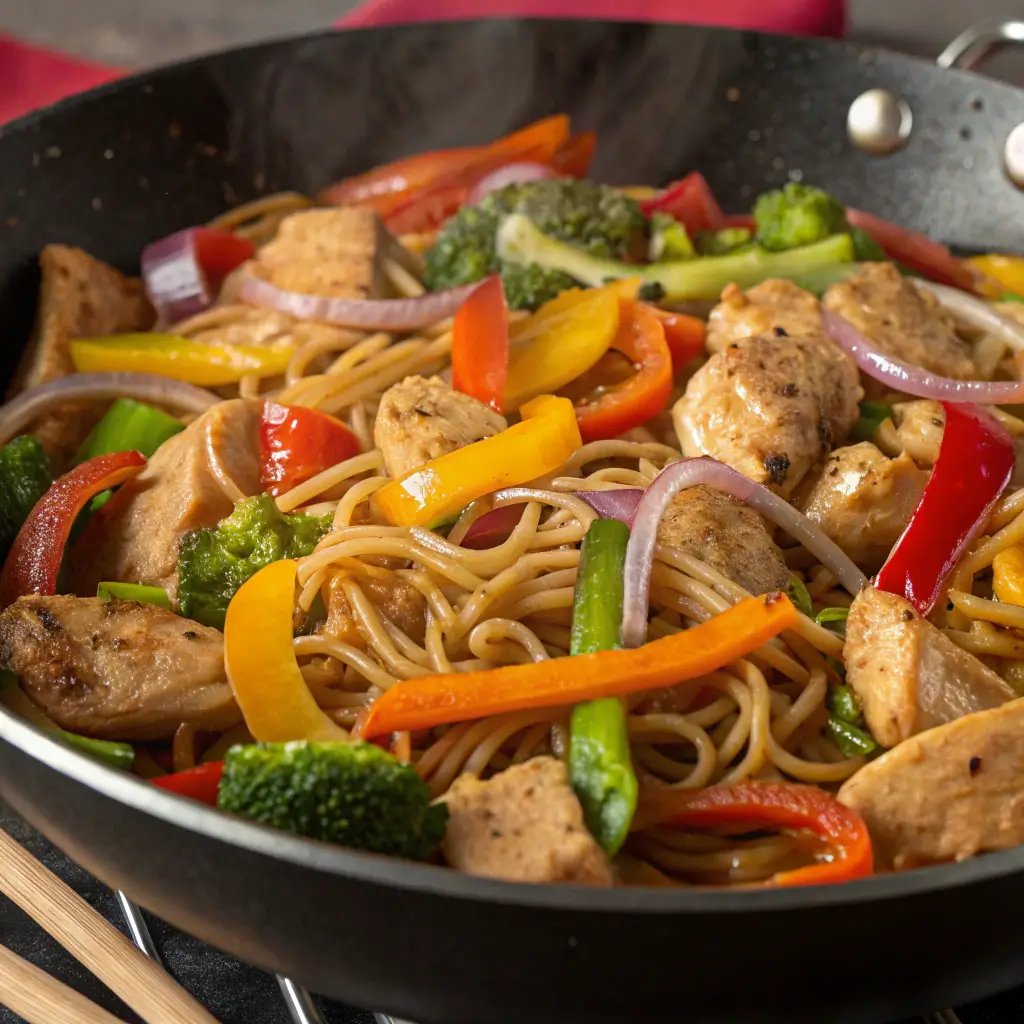The Ultimate Guide to Making a Delicious and Easy Chicken Stir-Fry
When it comes to quick, healthy, and flavorful meals, chicken stir-fry is a go-to option for many home cooks. Not only is it versatile, but it also allows you to pack in a variety of vegetables, proteins, and sauces to create a dish that’s both nutritious and satisfying. In this article, we’ll walk you through how to make an easy chicken stir-fry that’s perfect for busy weeknights or meal prepping. Plus, we’ll share tips to make your stir-fry stand out while keeping it simple and delicious.

Why Chicken Stir-Fry is a Kitchen Staple
Chicken stir-fry is a beloved dish for several reasons. First, it’s incredibly adaptable. You can use whatever vegetables you have on hand, swap out sauces, or even change up the protein if you’re feeling adventurous. Second, it’s a one-pan meal, meaning less cleanup and more time to enjoy your food. Lastly, it’s a fantastic way to incorporate lean protein and a variety of veggies into your diet.
Moreover, stir-frying is a cooking method that retains the nutrients in vegetables better than boiling or steaming. The high heat seals in flavors and textures, making every bite a delightful experience. Whether you’re a seasoned cook or a beginner, this recipe is designed to be foolproof and enjoyable.
Ingredients You’ll Need
Before we get started, let’s make sure we have all the ingredients ready. The beauty of this recipe lies in its flexibility, so feel free to customize based on your preferences or what’s in your fridge.
For the Chicken:
- 1 lb (450g) boneless, skinless chicken breasts or thighs, cut into thin slices
- 2 tablespoons soy sauce (low-sodium preferred)
- 1 tablespoon cornstarch
- 1 tablespoon olive oil or sesame oil
For the Stir-Fry:
- 1 red bell pepper, sliced
- 1 yellow bell pepper, sliced
- 2 cloves garlic, minced
- 1 cup broccoli florets
- 1 medium carrot, julienned
- 2 tablespoons olive oil or sesame oil (divided)
- A cup snap peas
- 1 small onion, thinly sliced
- 1 tablespoon fresh ginger, minced
For the Sauce:
- 1/4 cup soy sauce (low-sodium preferred)
- 1 tablespoon hoisin sauce
- 1 tablespoon honey or maple syrup
- 2 tablespoons oyster sauce (optional)
- 1 teaspoon rice vinegar
- 1 teaspoon sesame oil
- 1/2 teaspoon red pepper flakes (optional, for a touch of spice)
For Serving:
- Cooked rice (white, brown, or jasmine)
- Sesame seeds (for garnish)
- Green onions, chopped (for garnish)
Step-by-Step Instructions
Step 1: Prepare the Chicken
Start by slicing the chicken into thin, even strips. This guarantees the chicken cooks evenly and retains its tenderness. In a bowl, combine the chicken with soy sauce and cornstarch. The cornstarch helps tenderize the chicken and gives it a slightly crispy texture when cooked. Let it marinate for at least 10 minutes while you prep the vegetables.
Step 2: Chop the Vegetables
While the chicken is marinating, wash and chop all your vegetables. Uniform slicing is key here, as it ensures even cooking. If you’re short on time, you can use pre-cut veggies from the store, but fresh is always best for flavor and texture.
Step 3: Make the Sauce
In a small bowl, whisk together the soy sauce, oyster sauce (if using), hoisin sauce, honey, rice vinegar, sesame oil, and red pepper flakes. Set aside. This sauce is the heart of your stir-fry, so don’t skip this step!
Step 4: Cook the Chicken
Warm 1 tablespoon of oil in a large skillet or wok over medium-high heat until it glistens. Once shimmering, add the marinated chicken in a single layer. Cook for 3-4 minutes on each side until the chicken is golden brown and fully cooked. Remove the chicken and set it aside.
Step 5: Stir-Fry the Vegetables
Using the same pan, heat the remaining tablespoon of oil. Toss in the garlic and ginger, stirring for about 30 seconds until fragrant. Next, toss in the firmer vegetables like carrots and broccoli, as they require more time to cook. After 2-3 minutes, add the bell peppers, snap peas, and onions. Stir-fry for another 3-4 minutes until the vegetables are tender yet still crisp.
Step 6: Combine Everything
Add the cooked chicken back to the pan with the vegetables. Drizzle the sauce over the mixture and toss thoroughly until everything is well-coated. Heat for an additional 1-2 minutes to allow the flavors to blend.
Step 7: Serve and Enjoy
Plate the chicken stir-fry over steamed rice. Sprinkle with sesame seeds and chopped green onions for added flavor and a polished presentation.

Tips for the Perfect Chicken Stir-Fry
- Use High Heat: Stir-frying is all about high heat and quick cooking. This ensures your vegetables stay crisp and your chicken stays tender.
- Prep Ahead: Chop all your ingredients before you start cooking. Stir-fries come together quickly, so having everything ready is essential.
- Customize Your Veggies: Don’t be afraid to swap out vegetables based on what’s in season or what you have on hand. Zucchini, mushrooms, and cabbage are great additions.
- Don’t Overcrowd the Pan: Cook in batches if necessary. Overcrowding the pan can lead to steaming instead of stir-frying, which affects texture.
- Experiment with Sauces: If you’re not a fan of soy sauce, try teriyaki, peanut sauce, or even a simple garlic and ginger sauce.
Health Benefits of Chicken Stir-Fry
This dish isn’t just delicious—it’s also packed with nutrients. Chicken provides high-quality lean protein, crucial for building and maintaining muscle tissue. The variety of vegetables provides essential vitamins, minerals, and fiber, promoting overall health. Additionally, using minimal oil and low-sodium sauces keeps the dish light and heart-healthy.
Frequently Asked Questions
Can I Use Frozen Vegetables?
Yes, you can! However, frozen vegetables may release more water when cooked, so be sure to drain any excess liquid to avoid a soggy stir-fry.
How Do I Store Leftovers?
Store any remaining portions in an airtight container and refrigerate for up to 3 days. Reheat in a skillet or microwave until thoroughly warmed.
Can I Make This Gluten-Free?
Absolutely! Use tamari or a gluten-free soy sauce, and ensure your other sauces (like oyster sauce) are gluten-free as well.
The History of Stir-Fry
Stir-frying is a cooking technique that originated in China over 1,500 years ago. It was developed as a way to conserve fuel while cooking food quickly at high temperatures. The method spread across Asia and eventually became popular worldwide due to its efficiency and ability to retain the nutritional value of ingredients.
Interestingly, the wok, the traditional pan used for stir-frying, was designed to distribute heat evenly and allow for easy tossing of ingredients. Today, stir-fry dishes are celebrated for their versatility and ability to incorporate a wide range of flavors and textures.
How to Make Your Stir-Fry More Exciting
If you’re looking to elevate your chicken stir-fry, here are a few creative ideas:
- Add Nuts: Toss in some cashews, almonds, or peanuts for added crunch and protein.
- Incorporate Fruit: Pineapple or mango can add a sweet and tangy twist to your dish.
- Try Different Proteins: While this recipe focuses on chicken, you can easily substitute it with tofu, shrimp, or beef.
- Play with Herbs: Fresh herbs like cilantro, basil, or mint can add a burst of freshness to your stir-fry.
- Use Unique Vegetables: Experiment with less common veggies like bok choy, water chestnuts, or baby corn for a fun twist.
The Importance of Meal Prepping with Stir-Fry
Chicken stir-fry is an excellent option for meal prepping. You can cook a large batch at the beginning of the week and portion it out for lunches or dinners. To keep the vegetables crisp, store them separately from the sauce and combine everything when you’re ready to eat. This ensures your meal stays fresh and flavorful throughout the week.
Additionally, stir-fry is a great way to use up leftover vegetables or proteins. Instead of letting them go to waste, toss them into your stir-fry for a quick and satisfying meal.
Final Thoughts
Chicken stir-fry is a versatile, healthy, and delicious meal that’s perfect for any night of the week. With its combination of tender chicken, crisp vegetables, and a flavorful sauce, it’s a dish that never disappoints. Plus, it’s easy to customize based on your preferences or dietary needs.
By following this recipe, you’ll have a meal that’s not only satisfying but also packed with nutrients. So, grab your wok, gather your ingredients, and get ready to whip up a stir-fry that’s sure to become a family favorite. Happy cooking!
